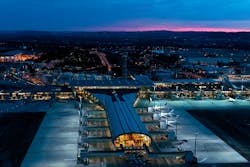Like most children, my two boys love candy. Before my eldest son’s recent birthday party, my wife and I prepared a piñata and left it unattended in the living room. The boys were intrigued by the colorful papier-mâché donkey, but much to our amusement, they had no idea what goodies lay within. This blissful ignorance meant the container remained largely undisturbed until the moment of the event.
My area of expertise is revenue management, and it wasn’t long before a connection to the piñata had formed in my mind. For the uninitiated, revenue management is the science of understanding the demand for a perishable product and determining the optimal pricing decision, at any given moment, to deliver maximum revenue.
In the early part of my career that meant enabling hotels to sell every room at the best possible price. Hotel owners and managers cracked open the proverbial piñata decades ago and they understand that selling those rooms at optimal prices will unleash the sweetest returns for their business. The hotel industry was an early adopter of revenue management and they have perfected those technologies and processes ever since.
As I look at the business of airports, I see quite a different picture. Historically, airports have relied heavily on the revenue from their airline partners, and in recent years, retail space has grown in commercial significance. In many cases, however, parking has been viewed similarly to how my boys saw the birthday piñata — just sitting there, with few appreciating the real potential within. It has largely remained a consistent but unexceptional money maker — fundamentally the means to get travelers to their flights, and little more.
For airports, parking is the untouched piñata and the opportunity to grow new revenue from parking is immediate, significant and critical.
Why Revenue Management?
A parking spot, like a hotel room, is a perishable asset. If the price is too high, the parking spot isn’t filled and it doesn’t generate any revenue. If it’s filled at a discounted price when the consumer is willing to pay more, the business misses out on additional revenue. If the parking spot isn’t sold that day, it cannot be sold again.
Despite this price sensitivity, most airports still use static price tiers or a one-size-fits-all approach to their parking pricing, leaving considerable revenue on the table. To be fair, many airports have recognized the shortcomings of this business practice but lack the resources, guidance and technology to kickstart the necessary shift. We all know change is hard but it’s also essential to our survival and I believe it was Albert Einstein who once said, “in the middle of difficulty lies opportunity.”
Join the Disruption
The way consumers shop, book, and pay has rapidly evolved. Consumers have grown to expect to be able to shop for products online or in the palm of their hand. And we take for granted that in other industries reservations can be made in advance. You wouldn’t, for instance, arrive at the airport without a ticket or travel to a destination with your fingers crossed that you could find a place to sleep once you got there. Most people wouldn’t even consider it and yet we don’t always give travelers the opportunity to guarantee a parking spot at their preferred terminal parking facility or give them the opportunity to get a better price by booking early.
Pre-booking parking systems are being increasingly adopted in airports worldwide. Reservation systems not only give busy travelers peace of mind but also provide data airports can use to understand and stimulate demand.
Trailblazing airports around the globe now use their parking data and predictive analytics to grow non-aeronautical revenue by being able to determine product and price availability based on the arrival and duration of stay of travelers. These trendsetters embrace the disruption in technology and mobility by applying demand-based, dynamic pricing to pre-booked parking with significant, year-over-year revenue growth.
Overcome Misplaced Fears
Some may worry fluctuating price points may deter potential parking business but we see across industries consumers accept pricing that shifts based on supply and demand. The ever-changing price of airline tickets, hotel rooms and even surge pricing in the Uber app have created a landscape in which consumers expect pricing to vary and are willing to pay for premium products based on convenience and value.
But this doesn’t mean swinging a bat blindfolded, wildly attacking the parking prize, like with my piñata. Airport parking pricing strategies should include a data-derived rate spectrum with a minimum floor and a maximum ceiling. That ceiling is typically your published drive-up rate, with discounted rates used as a means to optimize occupancy and revenues across multiple lots and to stimulate demand. And there’s no fear of cannibalizing drive-up business with the use of a good revenue optimization tool to manage these data-driven strategies.
Enact a Cultural Shift
Revenue management is a business culture, not just a pricing technique. In order to be effective, it has to be adopted and embraced at every level of the organization. Cooperation from leadership, finance, IT, operations, and marketing are all necessary for continued success. And technology alone does not guarantee revenue growth– partnering with an experienced revenue management solution provider will provide the right foundation for success.
For several years now, Auckland Airport, the largest and busiest in New Zealand, has leveraged sophisticated revenue management technology and dynamic pricing strategies to enhance their parking operation. They recently reported an 8.3 percent parking revenue uplift in 2018 compared to the year prior. Increased passenger numbers help but they attribute much of this continued growth to their refined revenue management practices and ongoing technology partnership.
Remove the Blindfold
Big data, artificial intelligence and deep machine learning aren’t just overused buzzwords — they’re the keys to taking a calculated blow to the parking piñata and also knowing how much candy is inside and even where it will fall. Thanks to advances in automated analytics technology, sophisticated tools are now available that remove the guesswork from forecasting and pricing, instead applying empirical science to derive data-driven pricing decisions.
Historical data from online reservation systems and parking access and revenue control systems can be used to identify regular patterns of buying behavior based on time of day, day of week and seasonality. Predictive analytics tools take this several steps further, ensuring historical transactions, competitor rates and forecast parameters such as price sensitivity, probability to purchase, length of stay and uncertainty influence the dema forecast and demand-based pricing decisions.
Revenue management is the way to finally crack the parking piñata wide open for airports. And for commercial teams willing to invest in their culture, fund their future and implement systems in line with current consumer behaviors and expectations, the prize is very sweet indeed.
Guy Barnes is the Head of Global Sales, Parking at IDeaS Revenue Solutions. Barnes has a 25-year history of building successful long-term partnerships with some of the world’s leading enterprise hotel groups, working with clients at every stage of their revenue journey. Today he is focused on driving commercial growth for airports through pricing and analytical solutions for their parking businesses.
IDeaS Enables Raleigh-Durham International Airport to Transform Its Parking Business
With passenger numbers exceeding 12.8 million in 2018, Raleigh-Durham International Airport (RDU) is the primary anchor for the popular Research Triangle destination of North Carolina. As the next step in its Parking Transformation Program, the Raleigh-Durham Airport Authority has partnered with IDeaS Revenue Solutions, the global leader in revenue management, to create a better parking experience and optimize space utilization.
The partnership aims to enhance RDU guests’ parking experience and returns from the airport’s 18,830 parking spaces—the largest source of revenue for the airport. IDeaS Car Park Revenue Management System (RMS) is a cloud-based forecasting and pricing solution that uses advanced SAS analytics, artificial intelligence and deep machine-learning to deliver optimal demand-based, dynamic pricing decisions fueled by a 365-day future view of parking demand.
- Focus on passenger experience – RDU aims to further transform its customers’ parking experience by changing the dialogue around parking to one of added value, ease and economy. IDeaS Car Park RMS is a complement to the ParkRDU parking reservation system it soft-launched in mid-2018 and will enable RDU to sell the right product, to the right customer, at the right price, at the right time.
- Airport parking in a sharing economy – It’s no secret one of the biggest challenges facing airport parking—including at RDU—is competition. To effectively compete, RDU aims to address the experience, convenience and value of parking over other modes of transportation. It is seeking to be competitively affordable for ParkRDU consumers
- A partner they can trust – Mindful of potential pitfalls when implementing new technology, RDU identified IDeaS Revenue Solutions as the right business partner because of its 30 years of revenue management experience—including an extensive list of airport parking clients—its industry-leading analytics and robust dynamic pricing tools, and its integrations with RDU’s other parking suppliers.
Michael Landguth, president and CEO of Raleigh-Durham Airport Authority, said,“IDeaS has the technology and expertise necessary to help us make informed decisions, shaping more effective marketing strategies, sales programs and overall airport parking revenue management. We are fortunate to have a renowned data-analytics partner right here in the Research Triangle.”
Guy Barnes, head of global sales, parking, IDeaS, said, “While the concept of demand-based dynamic pricing in the wider travel industry is not new, RDU is one of the first airports in the U.S. to further invest in its future by transforming its commercial strategy for parking. IDeaS is extremely excited to be a partner in its journey to drive new levels of revenue performance while continuing to improve customer experience.”
About the Author

